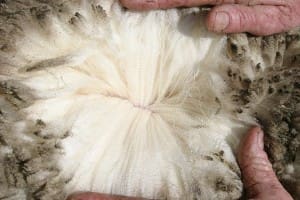 AUSTRALIA’S declining wool supply might continue to underpin and possibly extend the current Merino wool price ‘super-cycle’ being enjoyed by growers, leading market analyst Chris Wilcox said today.
AUSTRALIA’S declining wool supply might continue to underpin and possibly extend the current Merino wool price ‘super-cycle’ being enjoyed by growers, leading market analyst Chris Wilcox said today.
The Australian Wool Production Forecasting Committee today forecast that Australian shorn wool production will decline 0.6 percent from its 2016-17 level to 338 million kilograms greasy in 2017-18, due to largely to more difficult seasonal conditions in many major wool-growing areas.
This has resulted in lower fleece weights and comes despite the strong wool market conditions which are encouraging producers to retain sheep, the committee said.
The committee’s first forecast for shorn wool production for 2018-19 is 333 mkg greasy, a further fall of 1.7pc, due to a combination of slightly lower wool cuts per head and lower number of sheep shorn. This early forecast assumes normal seasonal conditions in 2018-19.
Mr Wilcox said the supply situation is continuing to support the current wool prices and might extend the ‘super-cycle’ for particularly Merino wool being pushed by synchronised economic growth in the United States and the European Union.
He believed some casual observers might be surprised that supply is likely to go down next season and not up, but seasonal conditions and higher prices for sheep are not helping producers who want to increase their flocks.
“The fact is the seasonal conditions around Australia are dry and aren’t conducive to rebuilding the flock, as you might expect given the current price levels.
“But supply wins the battle and demand wins the war,” he said.
“We’ll just have to see what happens with demand in the next couple of months, particularly given things like the dispute between the US and China on trade issues.
“In terms of the super-cycles, what we’ve seen in the past four super-cycles is something outside the wool industry has triggered a downturn from the super-cycle.”
Decline in fleece weights anticipated
AWPFC chairman, Russell Pattinson said seasonal conditions in the major sheep producing areas across Australia have been very dry through Summer and the first part of Autumn, which has resulted in lower than expected fleece weights.
While Tasmania and Western Victoria have experienced good seasonal conditions, some of the major sheep producing regions in New South Wales, eastern Victoria, South Australia, Western Australia and Queensland have been very dry. Wool production reductions are greatest in WA (down 7.3pc), Queensland and NSW while Victoria showed the largest increase (up 5.7pc) with slight increases in SA and Tasmania.
“While the committee expected that fleece weights would pull back as the season progressed, the decline has been more than anticipated.
“This is reflected in the drop in wool tests by AWTA in February and March,” he said.
“Furthermore, the high wool prices encouraged producers to shear their sheep earlier and the volume of prematurely shorn wool has increased.
“This has contributed to the recent decline in wool test volumes as wool which normally would have been delivered in recent months was delivered earlier in the season,” Mr Pattinson said.
Mr Pattinson said the weight of wool tested by AWTA in the nine months of 2017-18 is now on par with the level in 2016-17, after being 5pc higher to November.
“The committee expected that wool volumes would slow in the second half of the season, but this slowdown has been more than anticipated.
“The committee expects this to continue in the remaining three months of the season.”
The AWPFC’s first forecast of shorn wool production for the coming 2018-19 season of 333 mkg greasy reflected the impact of the dry seasonal conditions recently and is the result of a small fall in both the number of sheep shorn and in average wool cuts per head.
The committee noted that for the 2017-18 season to March, the AWTA test data showed a significant decline in the weight of wool tested of 16.5 microns and finer, as well as a decline in the volume of 20 to 26 micron wool. Volumes have increased for other micron ranges.
The average mean fibre diameter for the season to March was 21.1 micron, up by 0.1 micron. Victoria, Tasmania and New South Wales all recorded a lift in mean fibre diameter for the season, while Western Australia has seen a fall of 0.6 micron. The mean fibre diameter was steady in Queensland and South Australia.
The committee said the average staple length across Australia has fallen by 1.8mm to 87mm, with all states recording shorter average staple length for the season to date.

HAVE YOUR SAY